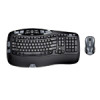Logitech Desktop Wave Making of Wave - Page 4
Design Concepts, Inspiration
 |
View all Logitech Desktop Wave manuals
Add to My Manuals
Save this manual to your list of manuals |
Page 4 highlights
Creating Comfort: The Making of the Logitech Comfort Wave Design - Page 4 that other specifications - key cap size, key travel - must also signal that this new keyboard was not a radical departure from the traditional, straight keyboard. Sauvage recommended additional specifications: The distance between each key ought to be a consistent 19 mm. Key travel ought to meet the recommended distance - 3.6 mm. Key-cap size ought to each be the same size as a standard, straight keyboard - 14 mm - so that, compared to traditional ergonomic keyboards with larger middle keys, there would be no visual confusion. With this knowledge in hand, Sauvage began sharing his findings with the rest of the development team, including Logitech's longtime industrial-design partner (who had also just finished working on the diNovo Edge keyboard), Design Partners, based outside of Dublin, Ireland. Design Concepts, Inspiration To develop a keyboard that delivered the maximum comfort, Sauvage and his team members saw a great opportunity. A wave-shaped key frame could reduce forearm pronation and finger static load. But what about wrist extension and ulnar deviation? To answer these questions, Logitech and Design Partners came together at the initial design identification (ID) exploration meeting to identify several options that could address all of the four pain points outlined by Sauvage: a curve, with an angle that would displace the key frame from the horizontal plane; a wave, which would displace the key frame from the vertical plane; and a palm rest, which would support the hands. = = cáÖìêÉ=O=p K=j t K= cáÖìêÉ=P K=j t K=EkçíÉW=q KF== cáÖìêÉ=Q=t~îÉJ K= After the meeting, development moved along two fronts. While Sauvage continued to define the specifications for individual keys, Design Partners began defining a design ID that would support a wave-shaped contour, and possibly a curved layout and a palm rest.










